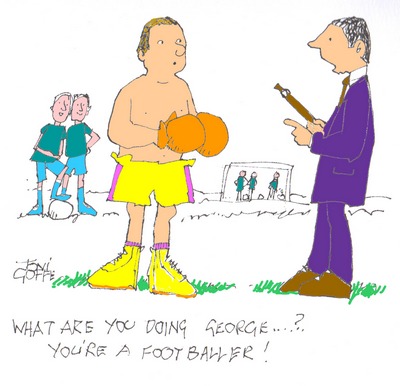EXERCISE AND INJURIES
I try to make these blogs topical, mostly reporting the results of recent investigations, trials or reports. Sometimes I am influenced by news stories which can highlight subjects of topical interest. Thus it is this week. There has been a rash of reports of sporting related injuries.
All exercise carries a small risk of minor injury such as muscle strain, joint sprain, bruises and cuts, most likely in contact sports. Some, though very rare, can be devastating – broken neck and paralysis in rugby players comes to mind. Most are thankfully minor.
Football and brain injuries
We know that boxing is bad for your brain – but what about football? There is worrying evidence that professional football players are also at risk. Researchers from the University of Glasgow compared differences in mortality from neurodegenerative disease (mainly deterioration in mental function) between former professional Scottish football players and the general population. 7676 former footballers born from 1900 to 1976 were compared with 23 028 matched controls from the general population.Over the 18 year study 1180 former footballers (15.4%) and 3807 matched controls (16.5%) died. The risk of dying from neurodegenerative disease was three and a half times higher in the former footballers. The risk of needing dementia treatment among the survivors was five times greater than in the non-footballers. This increased risk did not extend to the goalkeepers indicating the probable role of heading the ball. The mean age at death was 67.9 years in the former footballer group and 64.7 years in the matched controls. The footballers fared better because of lower rates of lung cancer and heart disease (on the whole exercise is good!).
I know that the FA is concerned by these findings but have no immediate plans to protect players. There is not a lot I can think of apart from either banning heading of the ball or allowing the wearing of protective helmets – neither is going to happen any time soon.
Is that all for football?
Another long-term result of playing football at this level is the very high risk of osteoarthritis (wear and tear type arthritis) particularly of the knee. Amateurs are also at risk though less so. Injuries are frequent in all football players, with knee and ankle accounting for the most severe injuries. Posttraumatic osteoarthritis is a common finding among ex-football players both amateur and professional with numbers well above that of the normal population. So if you are an amateur footballer you will live longer but you are more likely to need a new knee on the way.
Other sports
Curiously there has been a rash of recent reports of injuries from a number of different sports. Here are a few:
- Cycling. Head and facial injuries have remained constant despite the growing popularity of the sport though the rate of more serious injuries has increased.
- Ski-ing and snowboarding. Young children are at risk of facial and cranial injuries, including brain damage.
- Trampolining. This is growing in popularity in the US where it has long been a substantial contributor to broken bones in children. Trampoline-related fractures accounted for 3.6% of paediatric fractures in 2008. By 2017, trampoline injuries caused 6.2% of all broken bones in children.
- Swimming. Shoulder pain is particularly common in children involved in competitive swimming – but most carry on regardless.
Should these reports stop us exercising?
Definitely not – though I would not encourage boxing and reasonable care is needed in all sports which may cause collisions of one sort or another.
For amateur footballers the risk of brain injury from repeated heading of the ball is probably very low. However they do run an increased risk of developing arthritis of the knee and should therefore treat any knee injury seriously and allow time for recovery before resuming playing.
Otherwise the benefits of regular physical activity easily outweigh the ill effects. Most of the risk is concentrated in competitive sportsmen and sportswomen. The rest of us should just get on with it.
Subscribe to the blog
Categories
- Accelerometer
- Alzheimer's disease
- Blood pressure
- BMI
- Cancer
- Complications
- Coronary disease
- Cycling
- Dementia
- Diabetes
- Events
- Evidence
- Exercise promotion
- Frailty
- Healthspan
- Hearty News
- Hypertension
- Ill effects
- Infections
- Lifespan
- Lipids
- Lung disease
- Mental health
- Mental health
- Muscles
- Obesity
- Osteoporosis
- Oxygen uptake
- Parkinson's Disease
- Physical activity
- Physical fitness
- Pregnancy
- Running
- Sedentary behaviour
- Strength training
- Stroke
- Uncategorized
- Walking



Another excellent article, despite the risks inherent in being active, they are far outweighed by the risk of being inactive! Changing the weight of the football may have a significant effect, I well remember the effect of an impact with a soggy wet leather football on ones head from schooldays. Todays balls are much lighter and do not absorb water.